|
|
|
| My Favourite Planet > English > People > Mistress of Animals |
 |
back |
Mistress of Animals |
|
|
| |
Mistress of Animals
Ancient Greek mythology, religion and art
Potnia Theron (Ἡ Πότνια Θηρῶν), also referred to as the Mistress of Animals, Mistress of Beasts or Mistress of Wild Things, is the name given to female figures in ancient Minoan, Mycenaean, Greek and Etruscan art, shown with animals. The figures are often depicted with wings, holding animals in both hands. It is thought that the figures represent a nature goddess, although it is not certain exactly what significance such figures had in the different ages and cultures or whether they represent the same entity.
A Minoan figure, interpreted as a male deity, has been named the "Master of Animals" (see below), and Archaic representations of a Cypriot god have also been given this name.
The type of figure is thought to have originated in the Near East, and ancient artefacts from Syria and Mesopotamia are often cited as antecedents. [1] Again, there is no certainty of a direct connection between the figures from these cultures and those from around the Aegean or in Italy.
Mistress of Animals figures appear in Archaic Greek and Etruscan artworks in metal, ivory, pottery and jewellery from the 8th century BC, particularly in the Peloponnese and East Greece (eastern Aegean islands, Dodecanese and western Anatolia).
The name has been taken by modern scholars from a single mention in Homer's Iliad (Book 21, line 470) of Artemis as "the mistress of the wild beasts, Artemis of wild places" ("πότνια θηρῶν Ἄρτεμις ἀγροτέρη", Potnia Theron Artemis Agroteri).
The Ionian poet Anacreon (Ἀνακρέων ὁ Τήϊος, Anakreon of Teos, circa 582-485 BC), also referred to Artemis as the "mistress of wild beasts" in a fragment of a poem thought to be a prayer to the goddess on behalf of citizens of Magnesia on the Maeander in Caria, western Anatolia (Asia Minor). However, he may have borrowed the phrase from Homer.
"I implore you, deer-shooter, fair-haired daughter of Zeus, mistress of wild beasts, Artemis, who now somewhere by the eddies of Lethaios look upon a city of brave-hearted men and rejoice, for you shepherd citizens who are not savage." [2]
Anacreon, PMG fragment 348.
Representations of Artemis from Anatolia (Asia Minor), and particularly at Ephesus, as well as Archaic depictions of Artemis Orthia from the Peloponnese, show the goddess with animals, and have been referred to as Mistress of Animals figures. They have also been referred to by some scholars as "Persian Artemis", since the ancient iconography was already known from "oriental" artefacts such as gems from Iran and other places in the Middle East.
Minoan representations of a female figure with snakes, referred to as the "snake goddess" (see below), may or may not be related to to the Mistress of Animals. A 7th century BC terracotta plaque of a snake goddess was discovered in the Athens Agora in 1932 (see below). According to a recent theory, the figure may represent the goddess Demeter.
Whatever the significance of the Mistress and her identification as Artemis to people of the Archaic period and before, it seems that by at least the second century AD this knowledge may have become lost to most. The Greek travel writer Pauanias, who was fascinated by the history, art, culture, myth and religious matters in various places in the ancient world, and who may have been a native of western Anatolia (Asia Minor), appears to have been baffled by a depiction of Artemis as the Mistress of Animals on the "chest of Kypselos" at Olympia (probably 7th century BC, see Homer part 2). He not only expressed ignorance of the reason Artemis (her name probably inscribed next to the figure) was shown with wings, almost unknown in other types of images of the goddess, but he even considered it necessary to describe her pose holding animals, suggesting that the iconography may have been unfamiliar to him.
"On what account Artemis has wings on her shoulders I do not know; in her right hand she grips a leopard, in her left a lion."
Pausanias, Description of Greece, Book 5, chapter 19, section 5. At Perseus Digital Library. |
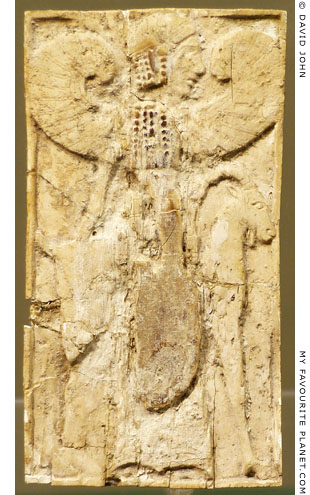
An ivory plaque with a depiction of
the "Mistress of Animals" in the
Peloponnesian tradition. 700-650 BC.
The figure, with sickle-shaped wings,
stands between a sitting bull or cow
and a standing goat.
Found in a tomb in Syracuse, Sicily.
Paolo Orsi Archaeological Museum,
Syracuse, Sicily. |
| |
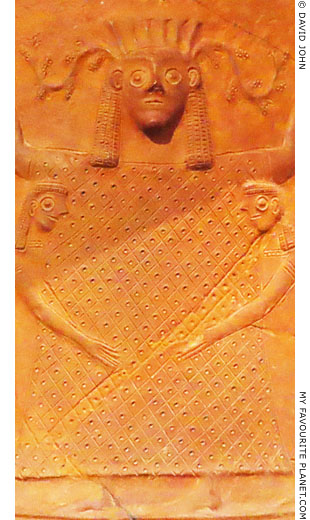
The "Mistress of Animals" on the neck of a
relief pithos made in a Cycladic workshop.
7th century BC. See below.
National Archaeological Museum,
Athens. Inv. No. 355. |
| |
| |
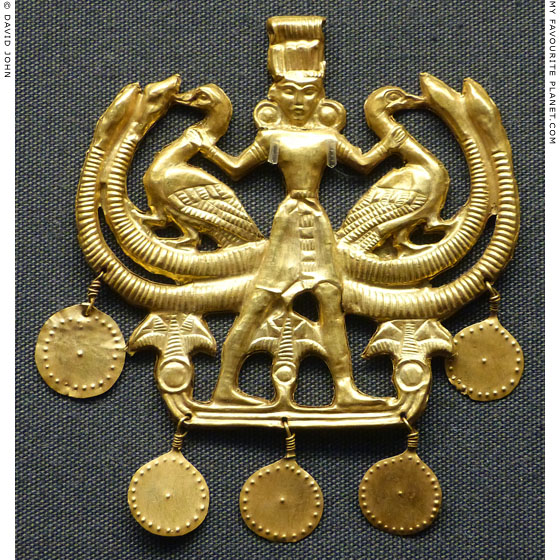
Minoan sheet gold pendant showing a Cretan nature god,
known as "the Master of Animals". Circa 1850-1550 BC.
The figure, wearing a tall headdress, Minoan kilt, earrings and bracelets, stands
in the attitude of the Master of Animals, holding two birds (geese or swans) by
their necks. The curved, ridged elements on either side of the birds are thought
to derive from stylized bulls' horns. Egyptian influence can be seen in the three
lotus flowers among which the figure stands.
From the "Aegina Treasure", a collection of Minoan jewellery
said to have been found in a tomb on the island of Aegina in 1891.
Height 6 cm, width 6.3 cm, weight 138 grains.
British Museum. Inv. No. GR 1892.5-20.8 (Jewellery 762). Purchased in 1892. |
| |
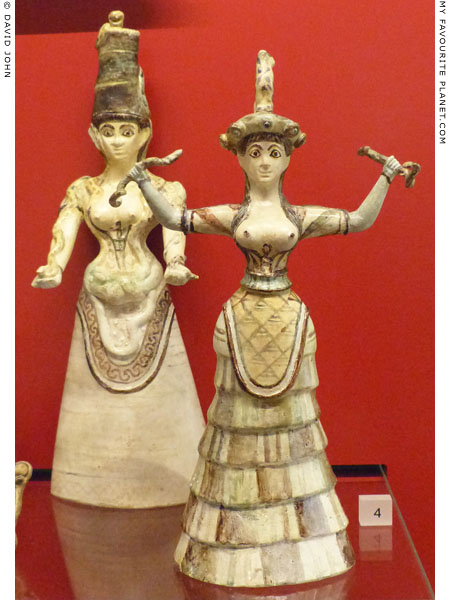
Replicas of two reconstructed faience figurines of Minoan "snake goddesses"
from the "Temple Repositories" in Knossos, Crete, 1650-1600 BC. Height 34.3 cm.
Casts made by Halvor Bagge (1866-1939?), a Danish artist who worked at Knossos
1902-1905. The original figurines, discovered in 1903 and reconstructed by
Arthur Evans, are in the Heraklion Archaeological Museum, Crete.
Ashmolean Museum, Oxford. Inv. No. AE. 1106, 1106 a. |
| |
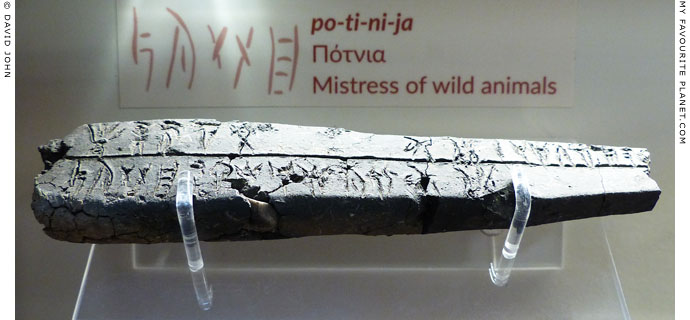
A fragment of a clay tablet inscribed in Linear B script, mentioning "Potnia" (po-ti-ni-ja; Πότνια).
13th century BC. From the archives of the Mycenaean palace of Thebes, Boeotia, central Greece.
One of a number of such fragments of tablets recording the dispatch of wool to female weavers
and embroiderers working in the service of deities such as Hera, Potnia and Hermes.
Thebes Archaeological Museum. |
| |
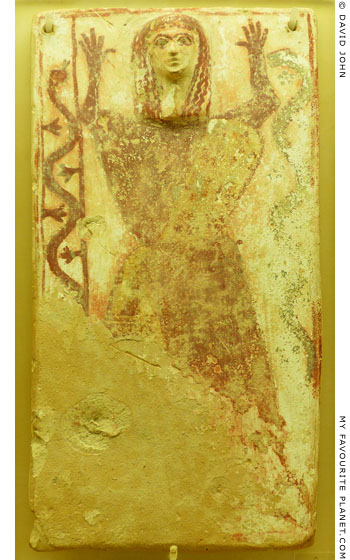 |
|
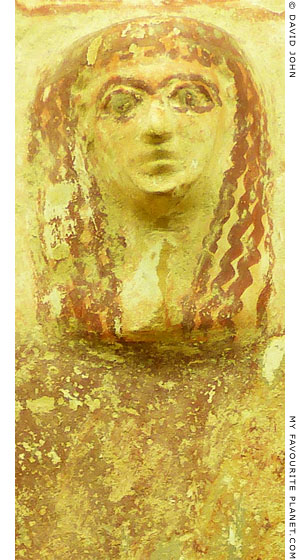 |
The "snake goddess plaque" discovered in the Athens Agora.
A painted terracotta votive plaque, dated to the mid 7th century BC,
with a depiction of a female figure standing between two snakes.
Height 24.8 cm, width (top) 13.3 cm, (bottom) 12.5 cm, thickness 1.1 cm.
Agora Museum, Athens. Inv. No. T 175.
|
|
The plaque was excavated in March 1932 in a deposit containing several other fragments of Proto-Attic ceramic objects, 1.9 metres west of the north-south wall of the Agora. The objects may have been brought from other locations outside the Agora, and used as fill material for the foundation of a path or road during the 7th century BC.
The painting is in deep red over a white slip, with some details in yellow and blue. There are holes in the upper corners, indicating that it was nailed to the wall of a building.
The figure, wearing a long, voluminous chiton, stands with both arms raised and with spread fingers; her thumbs are extended inwards, her palms facing forwards. Her head and neck are in relief, with the facial features modelled three dimensionally. Her painted hair has a curled fringe along the top of the forehead, with four wavy locks on each side of the head falling to her shoulders. The oval face has wide open, blue-green eyes, lined in red, with red-painted brows which meet above her nose and closed mouth.
Either side of the figure is a long snake with a wavy body taking up most of the height of the plaque, ending with a head just below the head of the goddess. The snake on the left, painted red, has a forked tongue, and is separated from the goddess by a painted frame from which plant-like forms extend horizontally into the spaces formed by the inner curves of the snake's body. The snake on the right is blue with a red outline; the spaces of the inner curves of the body have been filled with orientalizing dotted floral motifs.
It is thought that the scene represents an epiphany (ἐπιφάνεια), the goddess revealing or manifesting herself to her worshippers. According to a recent theory, the figure may depict the goddess Demeter, one of the Greek female deities associated with snakes. |
|
|
| |
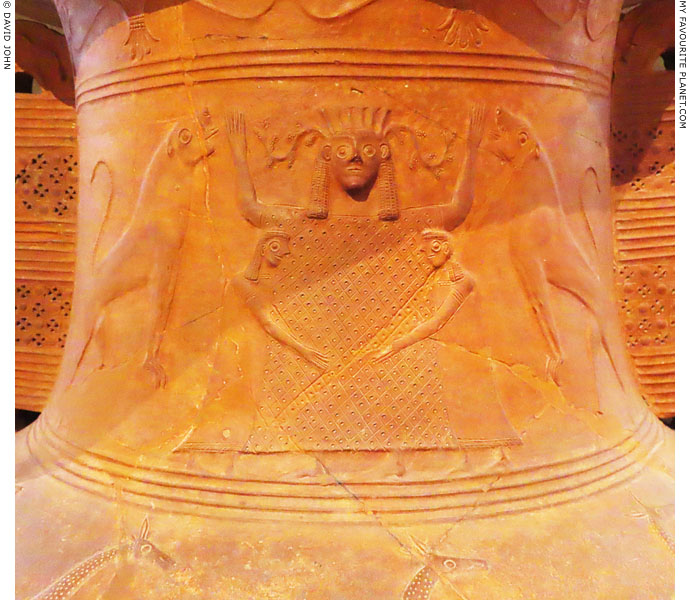
The "Mistress of Animals" on the neck of a relief pithos made in a workshop
in the Cycladic islands, 7th century BC. She stands in a frontal position with
her head facing forwards, her arms raised in a gesture of epiphany (as in
the "snake goddess plaque"above). She wears a crown, and from either
side of her head spread antler-like or branches covered in flowers. She is
flanked by two confronting, rearing lions (or lionesses), although they do
not touch her hands. She is embraced by two women worshippers, shown
at a smaller scale, who hold on to each side of her long garment.
From Thebes. 675-650 BC.
The vessel has been restored from several fragments. On the front
of the body is a relief of a row of does walking to the right, and on
the register below a row of stags grazing and walking to the left.
There appears to have been no relief decoration on the back.
National Archaeological Museum, Athens. Inv. No. 355.
It is thought that such relief pithoi (πίθος, storage jar; plural, pithoi, πίθοι),
large ceramic storage vessels decorated with a variety of figurative and
abstract designs, were produced in the 7th century BC in several places
around the Aegean (probably centred around Tenos), including the
Cyclades, Crete and Rhodes. They have also been found on Naxos, Melos,
Thera, Delos and Mykonos, as well as in Athens, Eretria and Boeotia.
See, for example:
The "Mykonos Vase", a large pithos made on Tenos around 675-650 BC, with
reliefs depicting the Trojan Horse (the Wooden Horse of Troy) and the sack of Troy.
A relief of Perseus and Medusa on a Cycladic pithos found in Thebes. |
| |
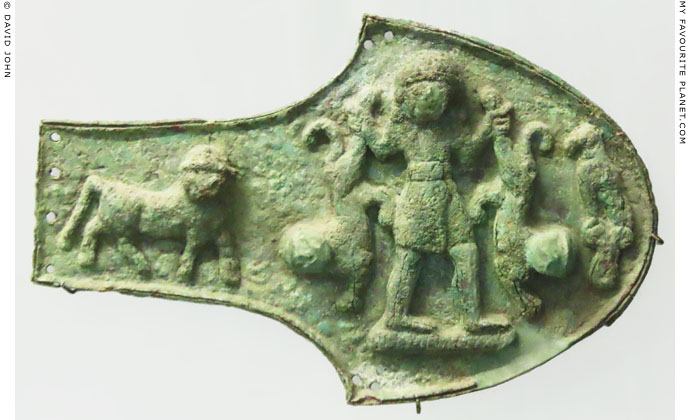
A bronze horse blinker from north Syria with a depiction of the "Master of Animals"
holding a lion by its tail in each hand.
9th century BC. Discovered in 1973 at the temple of Apollo Daphnephoros, Etertia,
Euboea, during excavations by the Swiss School of Archaeology in Greece.
Eretria Archaeological Museum. Inv. No. ME 7007.
|
A matching blinker, now in the National Archaeological Museum, Athens (Inv. No. X 15070), had been found earlier in Eretria, during excavations led by the Greek archaeologist Konstantinos Kourouniotis (Κωνσταντίνος Κουρουνιώτης, 1872-1945). His find was first published in 1933. The Aramaic inscription on the fragmentary blinker is now incomplete and difficult to read due to corrosion. However, an identical, more legible inscription was discovered on a decorated bronze frontlet, an ornament for a horse's forehead, with a very similar iconography, found more recently at the Heraion on Samos. The Samian inscription provided the key to that on the Eretrian blinker, which has been translated as:
"That which Hadad gave our lord Hazael from 'Umqi in the year that our lord crossed the river."
"Lord Hazael" is taken to be the king of Aram at Damascus (reigned circa 844-800 BC), mentioned in the Old Testament of the Bible (Book of Kings). The river may be the Euphrates. These are among a number of Hazael’s "booty inscriptions", found at ancient sites from the Aegean to Mesopotamia, which boast his military victories. Like many objects from distant lands dedicated at Greek sanctuaries, it is not certain how or when these blinkers ended up in Eretria. It is thought that the bronze frontlet was brought to Samos as a gift to Hera in the 7th century BC, perhaps as a souvenir obtained by Greek or foreign travellers (see, for example, an ivory lion from Egypt found at the Samian Heraion). |
|
|
| |
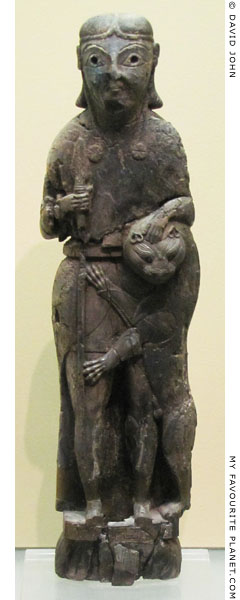
Archaic ivory statuette of a male figure in the
"Master of Animals" pose from Delphi, Greece.
Second half of the 7th century BC.
Height 22.5 cm, maximum width 6 cm.
Delphi Archaeological Museum. Inv. No. 9912.
|
Discovered in 1939 during the excavation of two deposition pits on the Sacred Way at Delphi, in which several votive objects, from the late 8th - 5th centuries BC, had been carefully buried after being damaged by a fire around 420 BC.
The back of the figure is flat, suggesting that it was an attachment for a box or piece of furniture. The figure may represent a hero or deity, perhaps Apollo, taming a wild animal as a symbol of nature itself. He holds a spear in his right hand, and his left hand rests on the head of a lion, shown at a smaller scale, standing on its hind paws in a pose reminiscent of heraldic iconography. He stands on a base decorated with a meander.
Thought to be a work of a Greek artist from East Greece (western Anatolia and eastern Aegean islands), with oriental influence. It is the only figure of this type found in Greece, and it has been suggested that it may have been made in Phrygia, Anatolia. It has even been suggested that it could be part of the throne dedicated to the Delphic Oracle by the Phrygian King Midas, mentioned by Herodotus (Histories, Book 1, chapter 14) [3]. |
|
|
| |
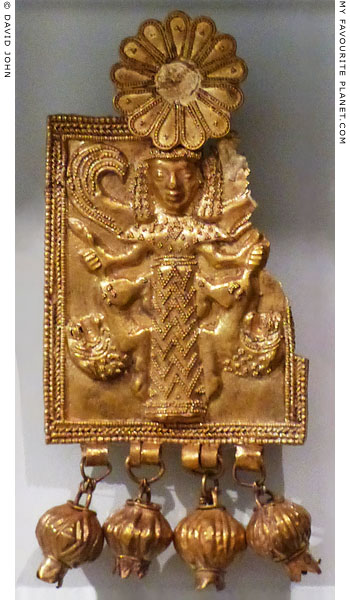
Gold plaque pendant with a depiction of the Mistress of Animals
in the Daedalic style. From Kamiros, Rhodes, 720-650 BC.
As in the plaque below, the figure thought by some scholars
to depict Artemis, wears a long chiton, has sickle-shaped
wings and holds in each hand a lion by a rear leg or tail. [4]
Ashmolean Museum, Oxford. Inv. No. AN 1896-1908 G.441. |
| |
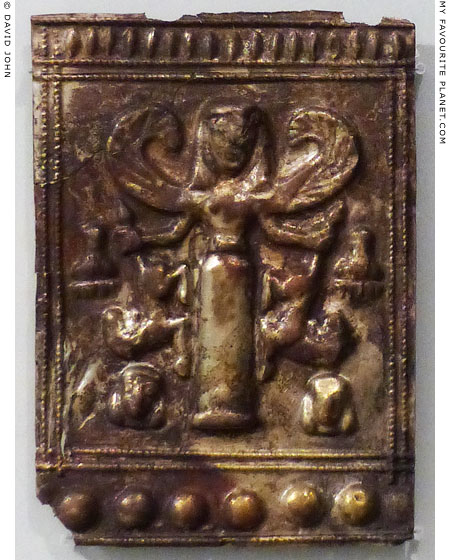
Electrum plaque with a depiction of the Mistress of Animals.
From Kamiros, Rhodes, 720-600 BC.
On either side of the figure is an object, which
appears to be a flask on a shelf, and a head.
Ashmolean Museum, Oxford.
One of a group of objects, Inv. Nos. AN 1896-1908 G.439 - G.442. |
| |
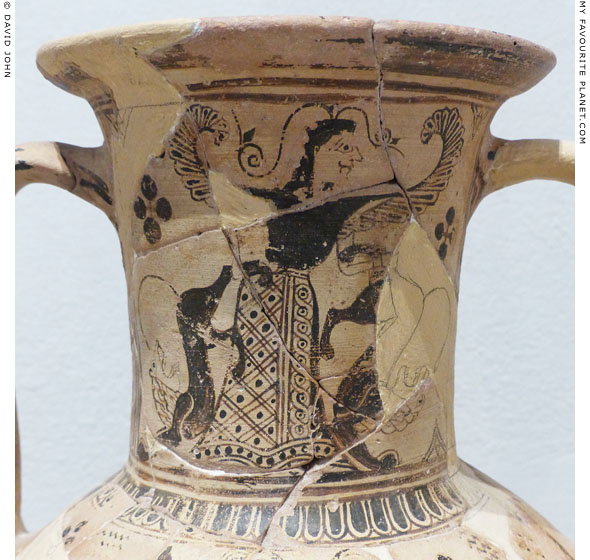
Neck of a Cycladic amphora with a depiction
of the Mistress of Animals holding two lions.
Made in Paros or Naxos around 700-675 BC. Found in the
"Purification Pit" on Rheneia (Ρήνεια) island, west of Delos.
Mykonos Archaeological Museum. Inv. No. IA 401.
|
Delos was first "purified" around 543 BC by the Athenian tyrant Peisistratos, who ordered the removal of graves within sight of the sanctuary of Apollo. A second purification was commanded by the Athenian democracy in 426/425 BC. The contents of all graves on the island were removed to the neighbouring island of Rheneia (Ρήνεια), and it was forbidden for anybody to give birth or die on Delos (Thucydides, History of the Peloponnesian War, Book 3, chapter 104).
The "Purification Pit" was discovered on Rheneia in 1898 during excavations by Dimitrios Stavropoulos, Ephor of Antiquities for the Cyclades. The 20 square metre pit in a 500 square metre paved enclosure is thought to be where the contents of the graves from Delos were deposited. It contained a large number of bones and thousands of funerary offerings, mostly vases, dating from the Geometric period (9th - 8th centuries BC) to the years just before the second purification. The oldest vase discovered was a small 12th century alabastron. The Mykonos Archaeological Museum was built by the Greek Ministry of Education and the Archaeological Society of Athens in 1902 especially to house finds from Rheneia.
Most of the pottery of the late 8th and 7th century was from Paros and Naxos, reflecting the competition between the two powerful island states for control over sacred Delos. In many cases it is uncertain which of these islands produced particular vases. |
|
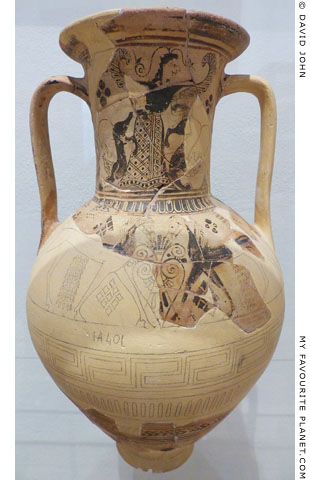
The Cycladic amphora from Rheneia.
On the reconstructed body are two
horses walking towards each other. |
|
| |
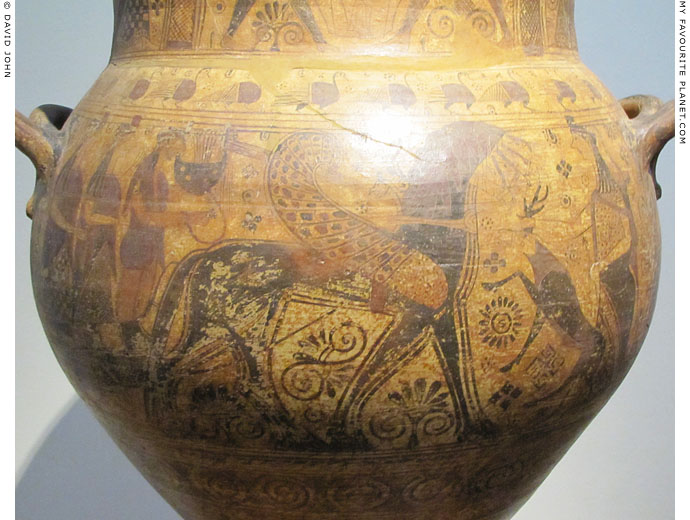
The body of a large Cycladic krater with a painting depicting Apollo (left) returning
to Delos from the land of the Hyperboreans, greeted by Artemis (right) holding
a deer by its antlers (see detail below).
Made in a Parian workshop, circa 640 BC.
Apollo, holding a kithara, stands in a chariot drawn by four winged horses, with two
female figures, perhaps Hyperborean maidens (or Artemis and Leto). Artemis holds
the deer with her right hand, and has an arrow in her left hand. Above the scene is
a continuous frieze of walking water birds. The neck of the krater shows two heroes,
perhaps Achilles and Memnon, engaged in Homeric combat (see Homer part 2).
National Archaeological Museum, Athens. Inv. No. 911. |
| |
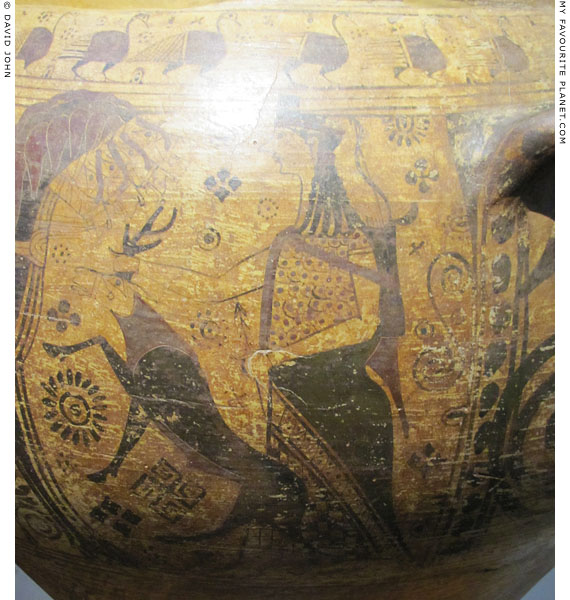
Artemis holding a deer by its antlers on the body of the Cycladic krater above. |
| |
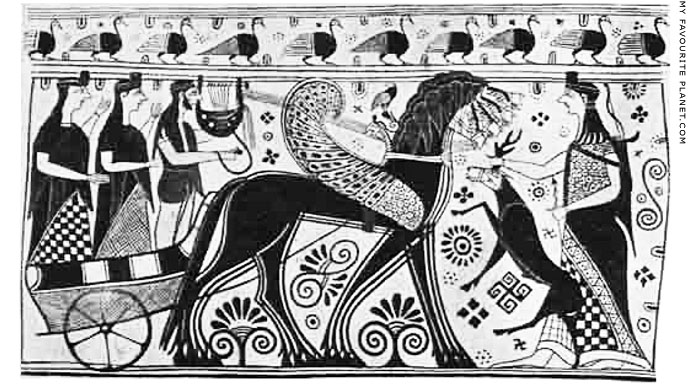
Drawing of the painting of Apollo and Artemis on the body of the Cycladic krater above.
Source: H. L. Lorrimer, Homer and the monuments, Plate XXXI, 2. MacMillan & Co.,
London, 1950. (The krater is described as a "Melian amphora".) |
| |
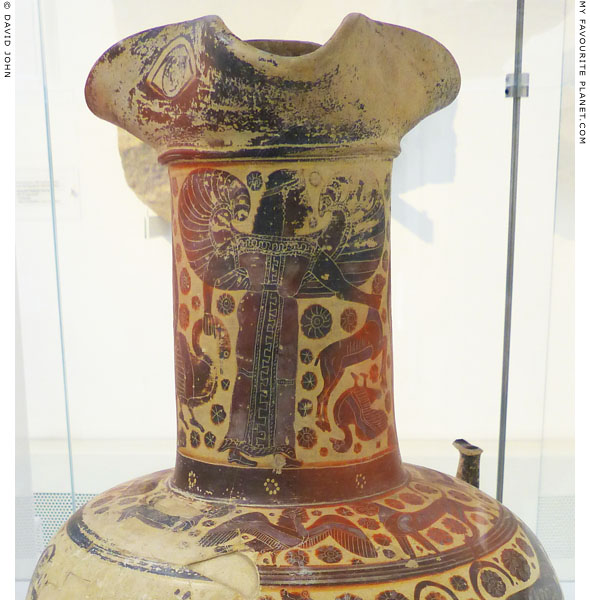
Neck of a Corinthian oinochoe (wine jug) with a depiction of the Mistress of Animals.
By the Palermo Painter, early 6th century BC. From Tomb 2,
Galera-Bagliazzo Necropolis, Selinous (Selinunte), Sicily.
Antonino Salinas Regional Archaeological Museum, Palermo, Sicily. |
| |
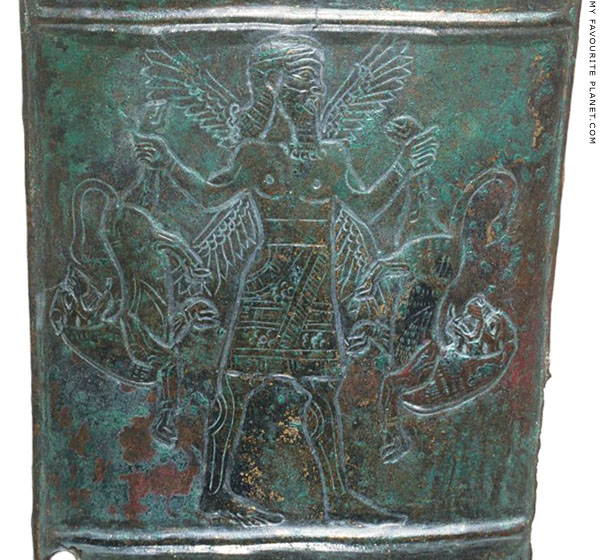
A relief of the Master of Animals on a bronze quiver cover
from Mesopotamia or western Iran.
Circa 9th - 8th century BC. Height 13.49 cm, width 54 cm.
Metropolitan Museum of Art, New York. Inv. No. 1989.281.28 (not on display).
From the Norbert Schimmel Collection (1974, No. 138).
Gift of the Norbert Schimmel Trust, 1989.
|
The reliefs on the quiver cover are similar in design to those on "Luristan bronzes" of around the same period, from the Lorestan Province in the Zagros Mountains of western Iran.
Five vertically arranged panels with reliefs depicting mythical scenes are separated by horizontal bands. From the top:
1. a god standing in a winged solar disc, holding a ring in his right hand, flanked by two horned and bearded deities;
2 and 4. rectangular landscape areas (gardens or pools?) surrounded by plants and mountains;
3. a winged male holding in each hand a lion by a rear paw (photo above);
5. a male figure (a hero, king or god) killing a lion with a spear.
Photo source: Public domain photo at
metmuseum.org/art/collection/search/327417.
See also: Jürgen Settgast (Editor), Von Troja bis Amarna: The Norbert Schimmel Collection, New York, Cat. No. 162, "Beschlag eines Köchers". Verlag Philipp von Zabern, Mainz, 1978. |
|

The bronze quiver cover in
the Metropolitan Museum. |
|
| |
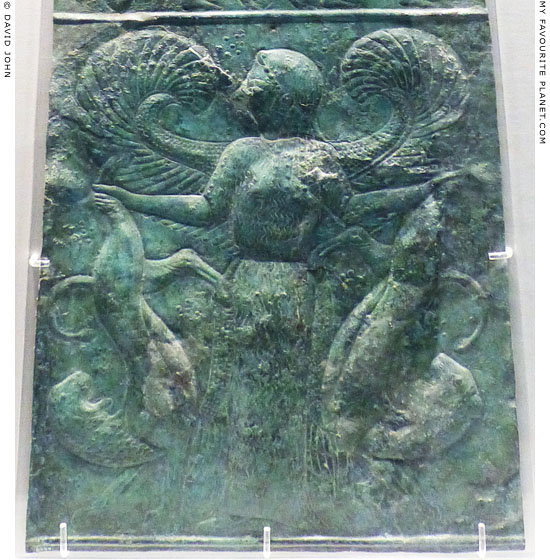
An embossed relief of the Mistress of Animals on a bronze sheet
from the Sanctuary of Olympia, Greece.
Around 600 BC. Height 88 cm, width 36 cm, depth 4 cm.
National Archaeological Museum, Athens. Inv. No. 6444.
|
The trapezoidal bronze sheet, possibly made in a Samian workshop, is thought to have been a decorative cover for an object in the sanctuary. Like the Iranian/Mesopotamian bronze quiver plaque above, the vertically arranged panels with reliefs of mythical figures are separated by horizontal bands. From the top:
1. three eagles;
2. two confronted griffins;
3. Herakles shooting an arrow at a Centaur at the battle with the Centaurs on Mount Pholoe;
4. the Mistress of Animals holding in each hand a lion by a rear leg. |
|
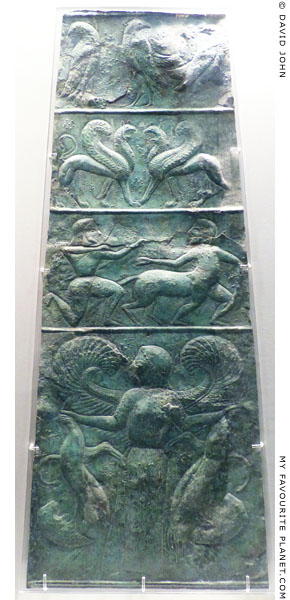
The bronze sheet from
the Sanctuary of Olympia. |
|
| |
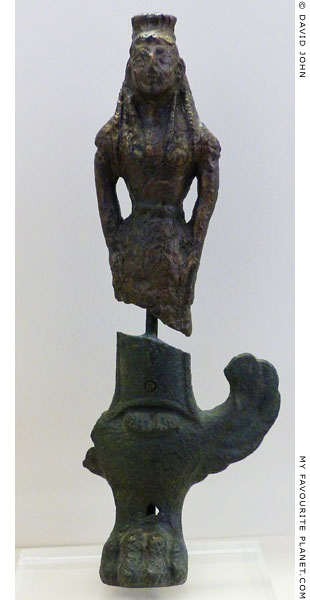 |
|
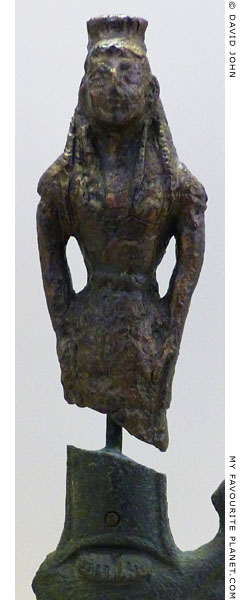 |
A standing female figure, probably the Mistress of Animals,
on a fragmentary bronze handle attachment with a lion foot.
"A typical work of early Laconian (Spartan) bronze sculpture", end of the
7th century BC. Excavated at the Sanctuary of Zeus, Olympia, Greece.
Olympia Archaeological Museum. |
|
| |
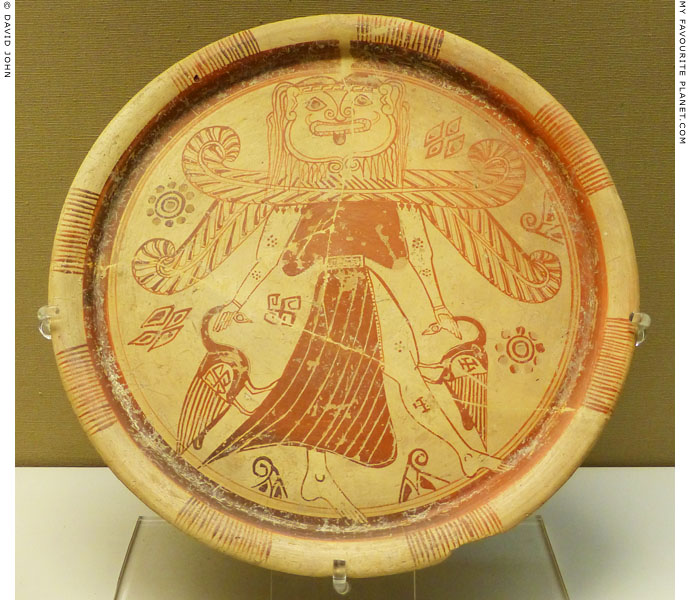
Ceramic plate showing a winged goddess with the head of a Gorgon,
wearing a split skirt, and holding in each hand a water bird by its neck.
Made on Kos about 600 BC. Excavated during the 1950s at Kamiros, western
Rhodes by Auguste Salzmann (1824-1872) and Sir Alfred Biliotti (1833-1915),
who sold it to the British Museum in 1860 along with other finds. Height 2.5 cm,
diameter 32 cm, weight: 1.19 kg.
The goddess is thought to be the Mistress of Animals, associated with or
identified as Artemis by some scholars. It is not known why the figure on
this plate has a Gorgon's head, or to put it another way, why a Gorgon was
depicted as the Mistress of Animals. See further discussion in Medusa part 3.
British Museum. Inv. No. GR 1860.4-4.2 (Vase G13/6). |
| |
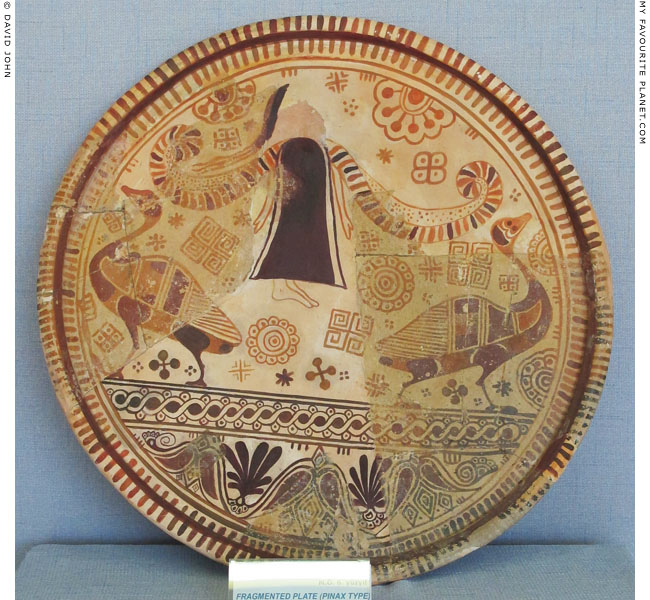
Restored fragmented ceramic plate (pinax type) showing
a winged female figure standing between two geese.
6th century BC. From Bayrakli, Smyrna (Izmir, Turkey).
Department of Ceramics, Izmir Museum of History and Art. |
| |
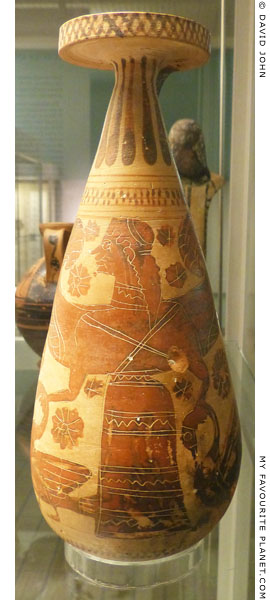 |
|
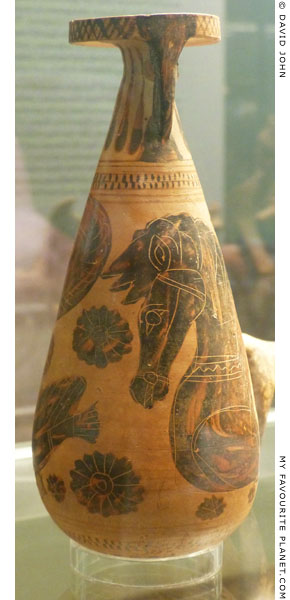 |
Boeotian alabastron (bottle for oil or perfume) with a Mistress of Animals holding
a water bird in each hand. The other side shows the upper part of a horse.
Around 550 BC. The name vase of the Horse-bird Group. Said to be from Corinth.
British Museum. Inv. No. GR 1894.10-31.1. |
|
| |
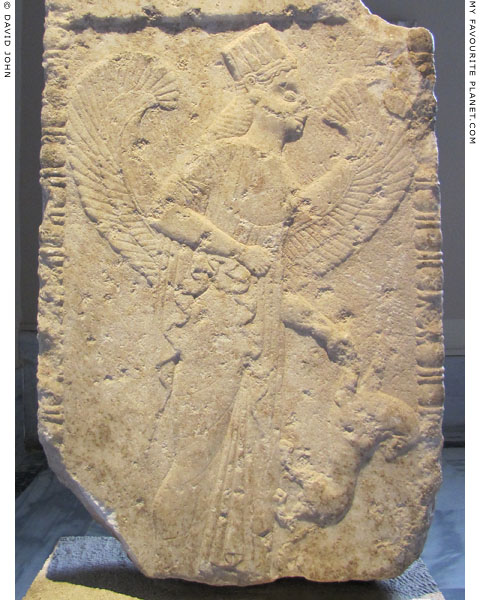
Detail of a marble grave stele with a relief of a winged goddess
holding a lion by a front paw. Around 525 BC.
Found in 1893 in Dorylaeum (Δορύλαιον, Dorylaion),
Phrygia, northwestern Anatolia (today Eskişehir, Turkey).
Istanbul Archaeological Museum. Inv. No. 680. Cat. Mendel 526.
|
The top of the two-sided stele, now broken, was decorated on both sides with reliefs of palmettes, similar to the akroteria (roof decoration) of buildings. One side has the relief of the goddess, while on the other side are badly damaged reliefs in two registers: the upper register depicts a youth in profile riding a horse to the right, accompanied by a walking male figure and a dog; the lower register shows two-horse chariot driven to the right by a male figure (perhaps representing Death).
The figure of the goddess, walking to right, is almost complete apart from the missing feet. She has sickle-shaped wings which emanate from behind her waist. On her head is a polos decorated with triangular rays. A thick swathe of hair falls in neat rows from the back of her head to behind her shoulders. She wears a peplos over a chiton, fastened by three buttons at her right shoulder. Her right breast and lower right leg are bare. In her right hand she apears to be holding an object, possibly a flower or plant tendril, in her left hand she grasps the left forepaw of a lion which hangs vertically with its head facing downwards.
The best known Archaic grave markers in the form of tall steles (or stelai) with reliefs were made in Athens and Attica in the 6th and early 5th century BC (see, for example the grave stele of Aristion by Aristokles), after which they ceased to be made there. However, the production of Attic type grave steles continued beyond the Early Classical period (mid 5th century BC) in other places in Greece, for example in northern Greece, where double sided reliefs have been found. Steles from other places in the Greek world often feature very different types of iconography.
Following this stele's discovery in 1893, several scholars speculated over the identity of the goddess, with theories summarized in 1895 by the German classical philologist Alfred Körte [5]. The relief figures were compared to Attic works and reliefs from the column bases of the Temple of Artemis in Ephesus. The white, crystalline marble was considered to be from an Aegean island, and the sculptor from Ionia (East Greece).
It was suggested that the stele was made for a Phrygian or Persian client (Phrygia had become part of the Persian Achaemenid Empire during the 540s BC, following Cyrus the Great's conquest of Lydia). The client may have identified the deity as the Persian goddess Anahita ("the Persian Artemis", a theory which Körte refuted) or the Phrygian mother goddesss Kybele. However, according to Körte, in the artist's mind she was Potnia Theron as Artemis.
It has also been suggested that the deity was believed to be the protector of the dead, in this case presumably the deceased horseman shown on the other side of the stele.
Height of surviving fragment of the stele 72.5 cm,
width 37.5 - 39 cm, depth 12 - 13 cm. |
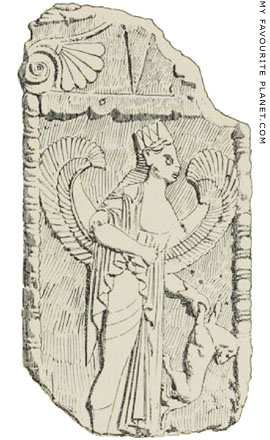
Drawing of the Dorylaeum stele
from Gustave Mendel's catalogue
of sculptures in the Istanbul
Archaeological Museum [6]. |
| |
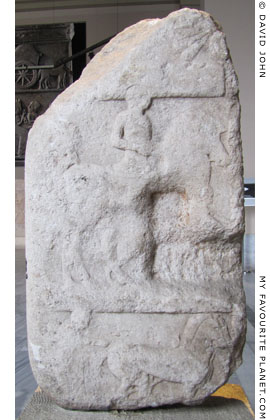
The other side of the Dorylaeum stele. |
| |
| |
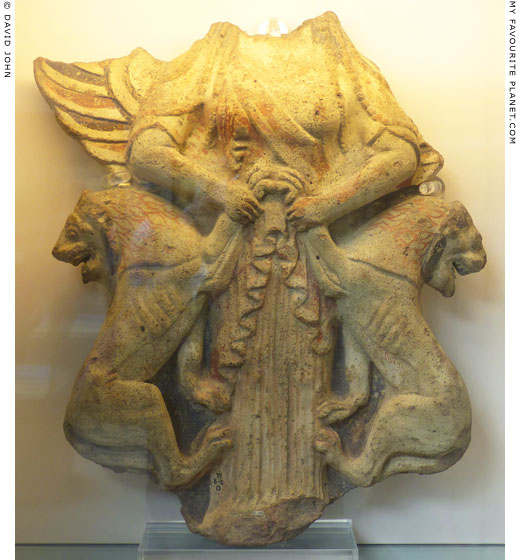
A terracotta antefix (decorated end of a roof tile) with a
winged figure of Artemis holding two lions by their front paws.
Made in Campania (southern Italy) around 500-480 BC.
From Capua. The figure combines Greek and Etruscan styles.
British Museum. Inv. No. GR 1877.8-2.13 (Terracotta B 588).
Donated by Alessandro Castellani. |
| |
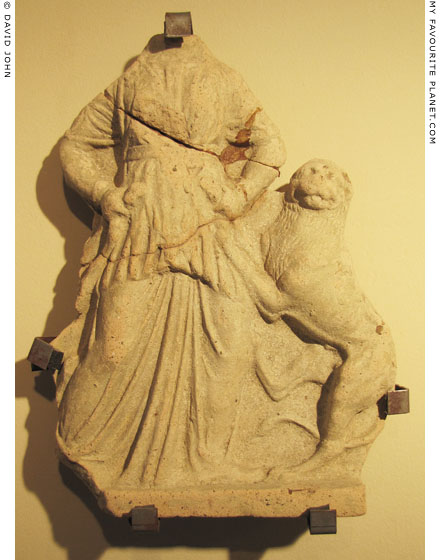
A fragment of a terracotta antefix (end of a roof tile, see Medusa part 4)
thought to depict a Maenad (see Dionysus) between two "panthers",
only one of which has survived. The now headless figure grasps a
forepaw of each of the cats in the manner of the Mistress of Animals.
4th - 3rd century BC. From a Samnite sanctuary at Pietrabbondante,
Isernia province, Molise region, south-central Italy. [7] |
| |
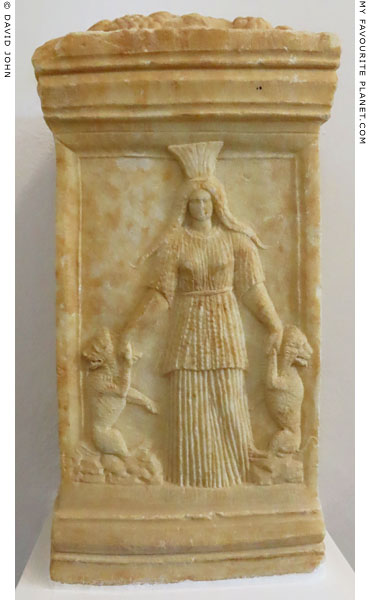
A relief of the "Mistress of Animals" on the front small marble altar.
The figure stands frontally, with long hair, parted in the middle and
flowing over her shoulders, wearing a polos and a peplos. In each
hand she holds a forepaw of a lion, shown at smaller scale, which
hangs vertically with its head facing outwards. The other three
sides of the the altar are not decorated. On top is a relief of
a wreath, its centre forming the space for the sacrifice.
Roman period. From Rhodes.
Rhodes Archaeological Museum. Inv. No. 13643. |
| |
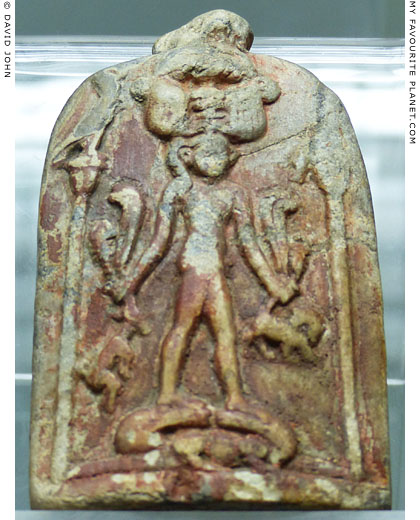
A small Egyptian stele with a relief of the head
of Bes over a standing figure of the god Horus
as a child in the pose of the Master of Animals.
National Archaeological Museum, Naples. Egyptian Collection.
|
| One of several similar surviving depictions of the child Horus (known as Hor-sched), which were set up as protective talismen in private homes, although some have also been found in graves. Above him is the head of the god Bes as the protector of the home and family, particularly the women and children. Horus stands frontally with each foot on a crocodile, holding in each hand two serpents and a scorpion. He also holds with his left hand a lion by the tail, and with the right hand an oryx (gazelle) by the horns. From the Hellenistic period the worship of the young Horus as Harpocrates (Ἁρποκράτης) was developed by the Greeks in Ptolemaic Alexandria. |
|
|
| |
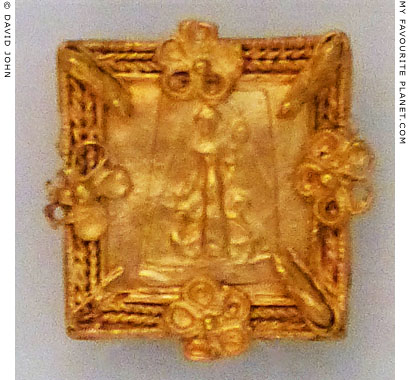
Small gold plaque showing the Mistress of Animals standing
between two lions. From Smyrna (Izmir, Turkey), 200-1 BC.
Ashmolean Museum, Oxford. Inv. No. AN1912.65. |
| |
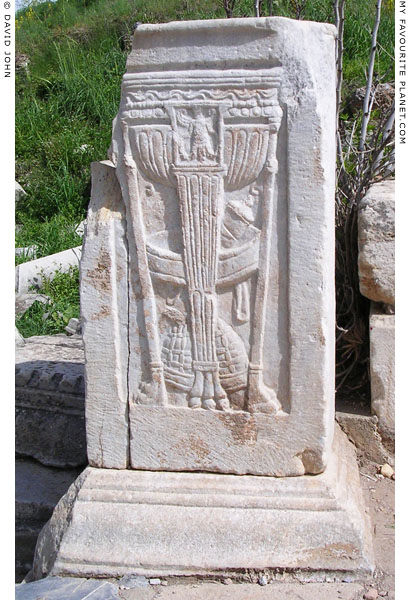
A relief in Ephesus depicting Apollo's tripod
with a plaque showing the Mistress of Animals.
|
One of the two matching, almost identical marble pedestals (bases for statues or pillars?) facing each other on either side of the of the bottom of the "Clivus Sacer" (Sacred Way) in Ephesus. This is the pedestal on the north side of the street (on the left as you go up the street, see Ephesus gallery page 12). On the side of the bowl of the tripod, above the central leg, is a plaque with a figure with sickle-shaped wings, holding an animal in each outstretched hand (see larger photo below).
The small image is badly worn on both pedestals, and it is not possible to tell whether the figure is male of female, or what animals he/she is holding. However, it is sufficiently similar to other depictions of the "Mistress of Animals" to safely assume that it is the same figure as, for example, on the Archaic gold plaques from Rhodes (see photos above). The figure in this case may be Artemis, the patron deity of Ephesus.
Between the lion-claw feet of the tripod is the omphalos, indicating that it belongs to the Delphic oracle of Apollo, the twin brother of Artemis. The pedestals may have been associated with a nearby sanctuary of the healing god Asklepios, Apollo's son. Alternatively, there may be a connection with the adjacent Prytaneion, or the Upper Agora. On the left (west) side of this pedestal is a relief of Hermes leading a male goat, and on the right side of the other pedestal Hermes walks with a ram.
The pedestals have been dated to somewhere between the 1st and 4th centuries AD (according to one source circa 3rd century AD), which is rather vague, and little seems to have been published about them. On one hand it is wonderful to see them on the street of Ephesus, but strange that they have been left here and not sheltered in the museum. |
|
|
| |
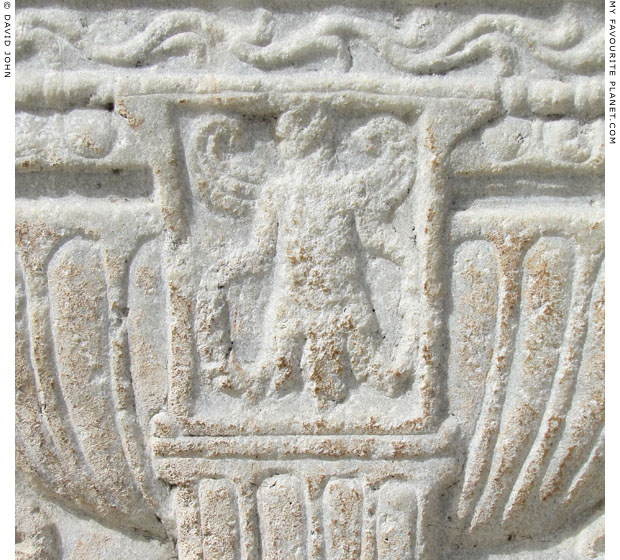
Detail of the relief on the pedestal on the north side of the street
in Ephesus, with the plaque showing the Mistress of Animals. |
| |
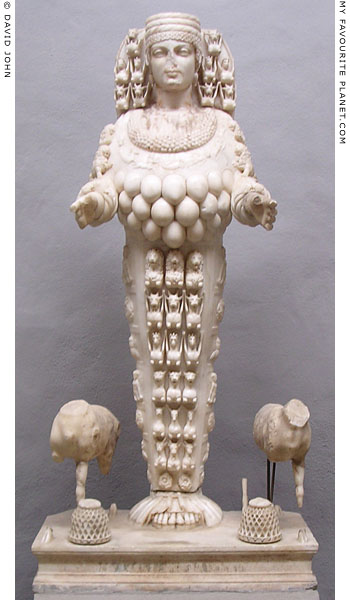
Statue of the goddess Artemis, known as the "Beautiful Artemis Ephesia".
Roman Imperial period, 125-175 AD. Discovered in 1956 in the Prytaneion
(town hall) of Ephesus. Thought to be a copy of a much more ancient cult
statue, perhaps of cedar wood, which stood in the Great Temple of Artemis
at Ephesus. Height 174.5 cm.
The goddess stands stiffly between two deer, her favoured animals,
and the figure is covered with reliefs, many of animals, including lions,
panthers, winged bulls, griffins, deer and bees.
Ephesus Archaeological Museum, Selçuk, Turkey. Inv. No. 718. |
| |
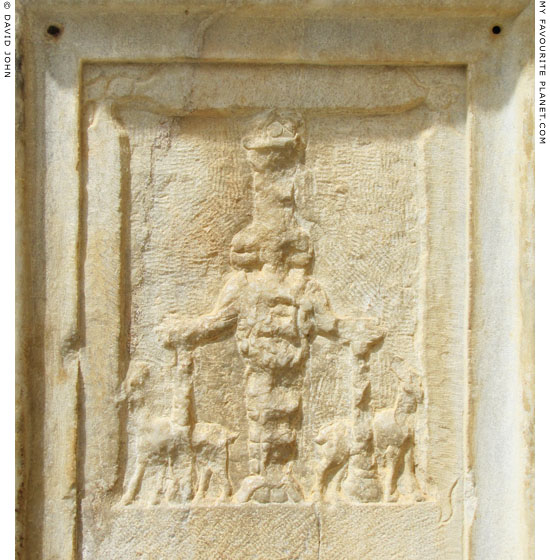
A rough relief of Artemis Ephesia, appearing more like graffiti, on the side
of a pilaster near the entrance to the Varius Baths, Ephesus. Roman period?. |
| |
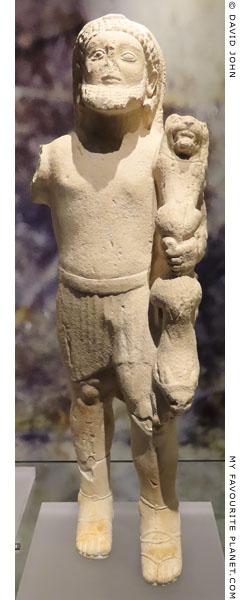 |
|
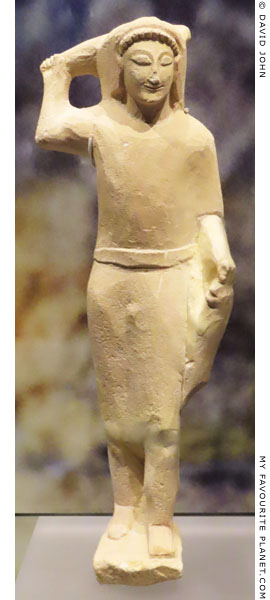 |
Two limestone statuettes of the god Herakles-Melqart
holding lions in the manner of the Master of Beasts. From Cyprus.
Left: This statuette has been dated to the Archaic period, 600-475 BC. The figure has
a beard but no moustache, wears a lionskin over the back of his head and a short,
girdled tunic with a pleated killt. In his clenched left hand he holds two lions by their
tails. the right arm is now missing. Provenance unknown.
Bank of Cyprus Cultural Foundation.
Right: the beardless figure is about half the size of the other statuette and less
detailed. Classical period, around 450-350 BC. He wears a lionskin on his head and a
knee-length, girdled tunic with half-length sleeves. In his clenched left hand he holds
a lion by its tail, and in his raised right hand he holds a club. Provenance unknown.
Cyprus Archaeological Museum, Nicosia.
Statuettes exhibited in the exhibition Cyprus - Eiland in beweging (Cyprus - a dynamic island), Rijksmuseum van Oudheden, Leiden, 11 October 2019 - 15 March 2020. |
|
| |
Mistress
of Animals |
Notes, references and links |
 |
|
1. Asian antecedents of Master/Mistress of Animals type images
A Hittite rock-face relief known as the "Schwertgott" (Sword-God) in Yazilikay, central Anatolia, dated 1250-1220 BC, shows a male figure standing frontally with his head in profile facing left, holding in each hand a lion by one of its rear paws. The relief is still in situ; there is a plaster cast in the Staatliche Museen, Berlin.
See:
Ekrem Akurgal and Max Hirmer, Die Kunst der Hethiter, plates 82 and 83. Hirmer Verlag, Munich, 1976 (Sonderausgabe).
2. The eddies of Lethaios
The Lethaios river (Ληθαῖος), one of three rivers of that name, has its sources in Mount Pactyes in Caria, and runs south to become a tributary of the Maeander just southeast of Magnesia on the Maeander.
3. Delphi statuette from the throne of Midas?
The claim was made by Keith DeVries, a professor and curator at the University of Pennsylvania Museum, on 5th January 2002, at the 103rd Annual Meeting of the Archaeological Institute of America in Philadelphia, subsquently reported in the popular press and debated in academic articles.
See: Oscar White Muscarella, An Ivory Statuette from Delphi - Not from King Midas’s Throne. Source: Notes in History of Art, Volume 35, No. 1/2 (Fall 2015/Winter 2016), pages 182-193. At the University of Chicago Press Journals. |
|
|
4. Precious metal goddess plaques
A similar small metal plaque from a late 7th century BC grave near Kamiros, Rhodes has a repoussé relief of a frontally standing winged female holding in each hand what appears to be a large plant (the plants are described by the museum labelling as "rosettes") rather than a lion, and with a sun symbol with eight rays either side of her legs (see photo right). |
|
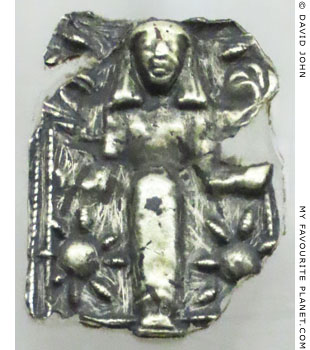
A silver plaque with a repoussé relief of
a "winged goddess holding rosettes".
From a pithos burial of an infant,
Kechraki T 210 (16). 625-600 BC.
Found during excavations in the
Archaic cemetery at Kechraki,
near the ancient city of Kamiros,
western Rhodes.
Rhodes Archaeological Museum. |
|
| |
5. Alfred Körte on the Dorylaeum relief
Alfred Koerte (1866-1946), Kleinasiatische Studien I: Eine archaische Stele aus Dorylaion, in Mitteilungen des Deutschen Archaeologischen Instituts, Athenische Abteilung, Band XX, 1895, pages 1-13, plates I and II. Verlag von Karl Wilberg, Athens, 1895.
6. The Dorylaeum relief in Mendel's catalogue
Gustave Mendel, Catalogue des sculptures Grecques Romaines et Byzantines, Tome Second, No. 526, pages 230-234. Musées Impériaux Ottoman, Constantinople, 1914. |
|
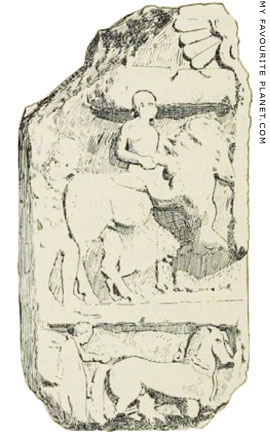
Drawing of the other side
of the Dorylaeum stele
in Mendel's catalogue. |
|
7. Maenad antefix from Pietrabbondante
The Samnites were an ancient Italic people who lived in Samnium in south-central Italy. Although often at war with the Greeks in Magna Gracia (southern Italy), they adopted several aspects of Greek culture, including the cult of Dionysus, and imported Greek goods such as Apulian ceramics.
Pietrabbondante is thought by some historians to be the location of ancient Bovianum, the meeting place of the assemblies of the confederation of the four Samnite tribes, the Caraceni, Caudini, Hirpini and Pentri. The site of the sanctuary there, first excavated in the 1840s, includes a theatre and a temple.
The antefix was exhibited as part of the temporary exhibition The gift of Dionysos in the Thessaloniki Archaeological Museum, 13 July 2011 - 30 September 2012. So far I have been unable to discover further details of the exhibits on loan from the Molise region of south-central Italy.
See further details on the Dionysus page. |
|
|
| |
Photos on this page were taken during
visits to the following museums:
Greece
Athens, Agora Museum
Athens, National Archaeological Museum
Delos Archaeological Museum
Delphi Archaeological Museum
Eretria Archaeological Museum
Mykonos Archaeological Museum
Olympia Archaeological Museum
Rhodes Archaeological Museum
Thebes Archaeological Museum
Thessaloniki Archaeological Museum
Italy
Naples, National Archaeological Museum
Italy - Sicily
Palermo, Antonino Salinas Regional Archaeological Museum
Syracuse, Paolo Orsi Archaeological Museum
Netherlands
Leiden, Rijksmuseum van Oudheden
Turkey
Ephesus archaeological site
Istanbul Archaeological Museum
Izmir Museum of History and Art
Selçuk, Ephesus Archaeological Museum
United Kingdom
London, British Museum
Oxford, Ashmolean Museum
Many thanks to the staff of these museums. |
|
| Photos and articles © David John, except where otherwise specified. |
 |
Visit the My Favourite Planet Group on Facebook.
Join the group, write a message or comment,
post photos and videos, start a discussion... |
|
|
| |
|
|
| |
| |
 |
| |
 |
| |
 |
| |
 |
| |
 |
| |
 |
| |
George Alvanos
rooms in
Kavala's historic Panagia District
Anthemiou 35,
Kavala, Greece
kavalarooms.gr
|
| |
Olive Garden Restaurant
Kastellorizo,
Greece
+30 22460 49 109
kastellorizo.de
|
| |
Papoutsis
Travel Agency
Kastellorizo,
Greece
+30 22460 49 286
greeklodgings.gr
|
| |
|